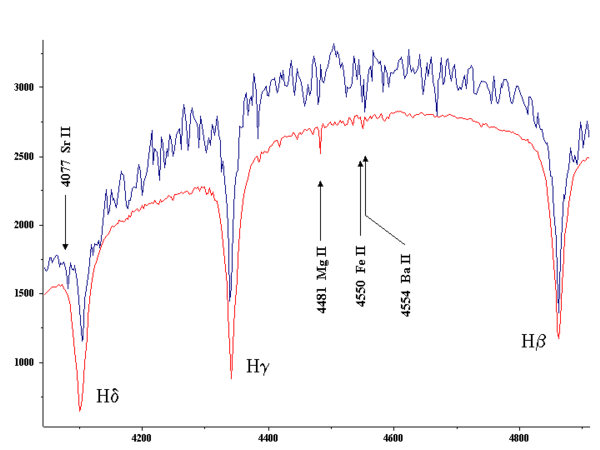SPECTRA OF PECULIAR STARS
Metallic A stars (Am)
Among the A class, the 25% of stars show some oddities. Among all these peculiar stars the most important classes are the metallic A stars (Am)
and the magnetic A stars (Ap).
Am stars, due to the strong intensity of their metallic lines were first classified in the F class and they were shifted to the A class only
after the discovery that their black-body temperature was in the range of the temperatures of A stars.
Among the elements that can be found in the atmosphere of these stars with abundancies up to 25 times the average we can find Stronzium,
Yttrium, Barium, Zirconium, Zinc and Copper.
On the contrary, sole light elements are underabundant, like Calcium and Scandium.

|
Picture 1: A part of the spectrum of the Am star 63 Tau (blue color), belonging to the Iades cluster,
recorded with 2.5 ┼/pixel dispersion and a 2 minutes exposure with a 0.6 m Cassegrain F/20 telescope.
As a comparison it is shown the spectrum of Vega (A0 V). It is clear that the metallic lines are over-abundant in the spectrum of 63 Tau,
particularly Barium and Strontium (10 to 25 times) and in a less extent also Iron and Chromium (3 to 5 times)
The Mg II 4481 ┼ line is only slightly more strong but it can be overlapped with other lines. Balmer lines are a bit less large and deep than Vega's and in fact the temperature of
63 Tau is only 7800 K, lower than Vega's. With this temperature, the MKK classification of 63 Tau is A7p.
|
The real physical processes involved in such an odd spectrum were first understood around 1970 when it become clear that Am stars
are all unusually slow rotators and that they belong to binary systems where the original fast rotation was slowed down by tidal forces
until star rotation was locked with orbital period.
Without a fast rotation and without convection that is typical only of colder stars, the atmospheres of these stars are extremely quiet
and superficial segregation phenomena can arise where the chemical composition is very different from that of deeper layers, producing
peculiar absorption spectra.
Among the Am stars we can find:
63 Tau (A7p), 60 Tau (A3p), 81 Tau (A5p), t Uma, 15 Uma, Mizar B, a Gem B,
8 Com, 15 Vul, 16 Ori (A2p)
 Go Back to the Home Page of peculiar stars Go Back to the Home Page of peculiar stars
|
|
 Go Back to the Home Page of peculiar stars
Go Back to the Home Page of peculiar stars

